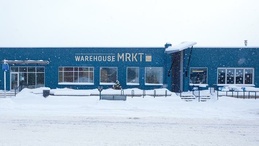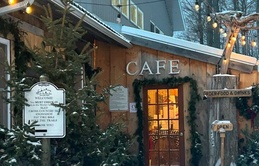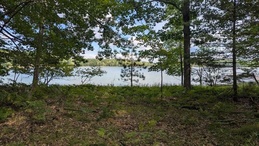Richard Schemm
Aug. 31, 2008
Walk into Richard Schemm’s studio in a cool forest valley west of Traverse City and you’ll be pleasantly overwhelmed by color and creative energy. Dozens of small paintings hang on the wall, surrounded by larger works in colors as vibrant and alive as the neon of butterfly wings.Schemm’s paintings have a distinct sense of depth. They contain veils, swirls, canyons and fissures that lead your eye ever deeper into the work. You get the sense that there is a ‘story’ within each painting, and if you go deep enough, your imagination will be fired with visions of what’s around the next bend in the canvas. There is a sublime power here -- and energy -- that goes far beyond other examples of abstract art in Northern Michigan.
“There’s a lot of storytelling in my work,” says Schemm, 56, whose personal intensity is as vibrant as his work. “In a way, these are not ‘abstract’ paintings. They’re abstract compared to realism, but they aren’t without content that informs.”
That content of Schemm’s paintings exists on a physical level as well as within the emotional/intellectual realm. “I think there are as many endorphins released from painting as there are from exercising,” Schemm says. “Frankly, that’s why people buy the stuff -- they get some kind of hit off the life I’m living.”
And although he has been a struggling artist for 20 years, Schemm says he’s been on an emotional thrill ride matched only be his unshakeable, uncompromising belief in his art. “I get to do one of the most thrilling things in the world,” he says. “And if I won the lottery tomorrow, I’d do the same thing I’m doing today.”
CONNECTION
But 20 years of struggle may be paying off for Schemm, because his work has been discovered by one of the most prestigious art galleries in the world, which has included him in several shows over the past year.
Last September, the Allan Stone Gallery on the upper east side of Manhattan exhibited five of Schemm’s paintings, debuting some of the best new artists of 2007. To his delight, he sold some work there, and also at a prestigious Art Basel show in Miami which the gallery sponsored. The gallery included his work at an additional show in Chicago.
“I was shaking with delight when I got the call to appear at the Allan Stone Gallery show,” he recalls. “It’s impossible to describe what it feels like to see your work on the walls of a perfectly hung show, with the paintings selling for $80,000 to $90,000 and the gallery filled with art lovers. It’s both a reward and an adventure.”
Schemm has been seeking the guidance of gallery director Claudia Stone, who took over the business 10 years ago after the passing of her father, legendary art collector Allan Stone.
Last February, she advised him to double his prices. That means a small work about six inches square goes for $1,200, with a wall-sized painting running $10,000. “Even so, I’m still the cheapest artist in the gallery,” Schemm says.
To put that in perspective, at one show, he says, “My work was hanging 10 feet away from a painting by Willem DeKooning that went for $1.1 million.”
Schemm notes that oil painting is an expensive process. He uses the highest quality paints, and a small tube containing ground turquoise runs $35. There’s literally a lot of money on a finished canvas.
“There’s something about oil painting that’s primal,” he says. “There’s colored clay from the earth in the paint, so each work has an earth vibration.”
JUNKYARD OF A GENIUS
If anyone would know what price to put on Schemm’s art, it’s Claudia Stone, one of six daughters raised by a father who collected some of the greatest artists of the 20th century.
Allan Stone started out as a lawyer in the 1950s. In the course of representing a number of artists, he fell in love with collecting and amassed one of the most exotic art collections in history. Stone collected everything from native art made from bird wings to the decapitated heads of a German missionary and his lover. Not to mention the works of Picasso, Van Gogh and DeKooning. When he died, his estate was valued at $1.4 billion. “He made it all by buying, selling and promoting art,” Schemm says.
Thus, today, inclusion in the Allan Stone Gallery means top drawer access to the fine art world and its patrons.
For Schemm, getting exhibited in the gallery is the end result of a 15-year quest.
“I had picked this gallery 15 years ago when I met Allan,” he recalls. “I was just learning how to paint and still had a lot to learn. I went to his gallery and there were all of these African masks, totems and everything you could imagine -- it was the junkyard of a genius. He was an intimidating man with a strong vital force.”
Stone advised Schemm to keep working at it, and he took him at his word. “Years later, I realized that this was the only gallery I wanted to be in, so I read all the rules for submissions and broke them.”
Here’s where the audacity of Richard Schemm comes in: In July of 2007, he drove to New York with 30 paintings, walked into the Allan Stone Gallery and dropped off a booklet featuring his art with an invitation to check out his work at a nearby hotel. Nothing happened right then, but once back in Michigan, Schemm got a call saying the gallery was interested in seeing 15 of his best paintings. He drove 800 miles all the way back to New York and within an hour and a half, found himself included in the gallery’s prestigious Talent 2007 show that fall.
LIVING THE DREAM
Today, Schemm hopes to be featured in a one-man show at the Allan Stone Gallery, but his inclusion there has already opened doors at other fine art galleries around the country. And at the recent Traverse City Film Festival, a visiting art professional from the University of Iceland took five of his paintings back home, promising that they’d be a smash in her country.
Schemm and social worker Pat Sparks, his partner of 19 years, live with her three daughters, Caitlin, Emma and Bryce, in a log home on 17 acres in Cedar Valley, west of Traverse City. A creek runs through the back yard of the property they bought in 1983. “I love the nature here, but have to go elsewhere for my civilization,” Schemm says, alluding to trips to art capitals such as New York. “Even though there’s a great deal of beauty here, I’m a studio artist and don’t paint outside.”
Born in Ann Arbor, Schemm grew up in Birmingham before his family moved to Bay City. As a teenager, he won a scholarship to the Cranbrook Academy of Art and he attended boarding school in Bloomfield Hills.
He had a brief brush with college, but developed an interest as a cabinet maker in his early 20s, traveling around the country in pursuit of the craft.
“What led me to painting was rubbing oil finishes into the grain of the wood on the cabinets I was working on,” he recalls. “I started seeing patterns and possibilities and began experimenting with watercolors. Because I wasn’t trained as a painter, I didn’t have any rules I was bound to.”
NEW YORK DAYS
Schemm gravitated to New York City in his mid-to-late 20s and began painting with oils. An early influence was the work of expressionist Willem de Kooning.
“I met a lot of older artists in New York who mentored me -- not so much in painting, but in what the artistic life is all about,” he says. “That means tenacity and sticking it out. Let’s face it, when you’re an artist, you’re alone -- the world you’re creating is three feet long... Painting is not about actually doing it -- it’s a way of living.”
For the past 15-20 years, Schemm has worked primarily as a painter, maintaining an unshakeable vision in the power of his work. But it hasn’t always been easy trying to create fine art in a region noted mostly for its landscapes -- a place where neo-impressionistic paintings of old barns, village marinas and kitschy folk art seems to prevail.
At times, Schemm has found himself cast in the role of an underdog: a group of local artists even dubbed themselves the “anti-Schemmites” a few years back in reaction to his exuberant, expressionist work. It’s a dig that he recalls with pride, along with a smile, considering something of an honor to be set apart from the trends of the local art scene.
“A while back I told my friend (artist) Glenn Wolff that I don’t care if I ever have a show here again,” he says. “I’ve had 50 shows in Traverse City, and you buy the champagne and go through the process of the reception and the exhibition; but there isn’t the daring and the risk-taking among the patrons of this town that there is even among the working class of New York.”
But you can still see Schemm’s work around the region: he has paintings at the Misfit Salon in Traverse City, Boutique a la Vie in Building 50 at the Grand Traverse Commons, Blu restaurant in Glen Arbor, and Les Femmes in Bay Harbor. And if history is any guide, chances are Schemm will continue to stage exhibitions in the North for some time to come: no one would ever call Richard Schemm a quitter.
And with his growing national credentials, gradually, Schemm is starting to see the realization of his dream of succeeding. “I think I may be one of those 30-year ‘overnight successes’,” he says with a laugh.
Trending

Farm to Glass with Ethanology
When Elk Rapids distillery Ethanology committed to locally-sourced ingredients for their products, it seemed like they&rsquo… Read More >>
MRKT HLDY SHPPNG, aka Warehouse MRKT Holiday Shopping!
Shop the latest from local makers and vendors at the Holiday MRKT Share at Warehouse MRKT in TC, Saturday, Dec. 20, from 10a… Read More >>
Men and Ugly Sweaters
Those two things don’t always go together, but on Dec. 19, you’ll see both out and about in Petoskey and Harbor … Read More >>


